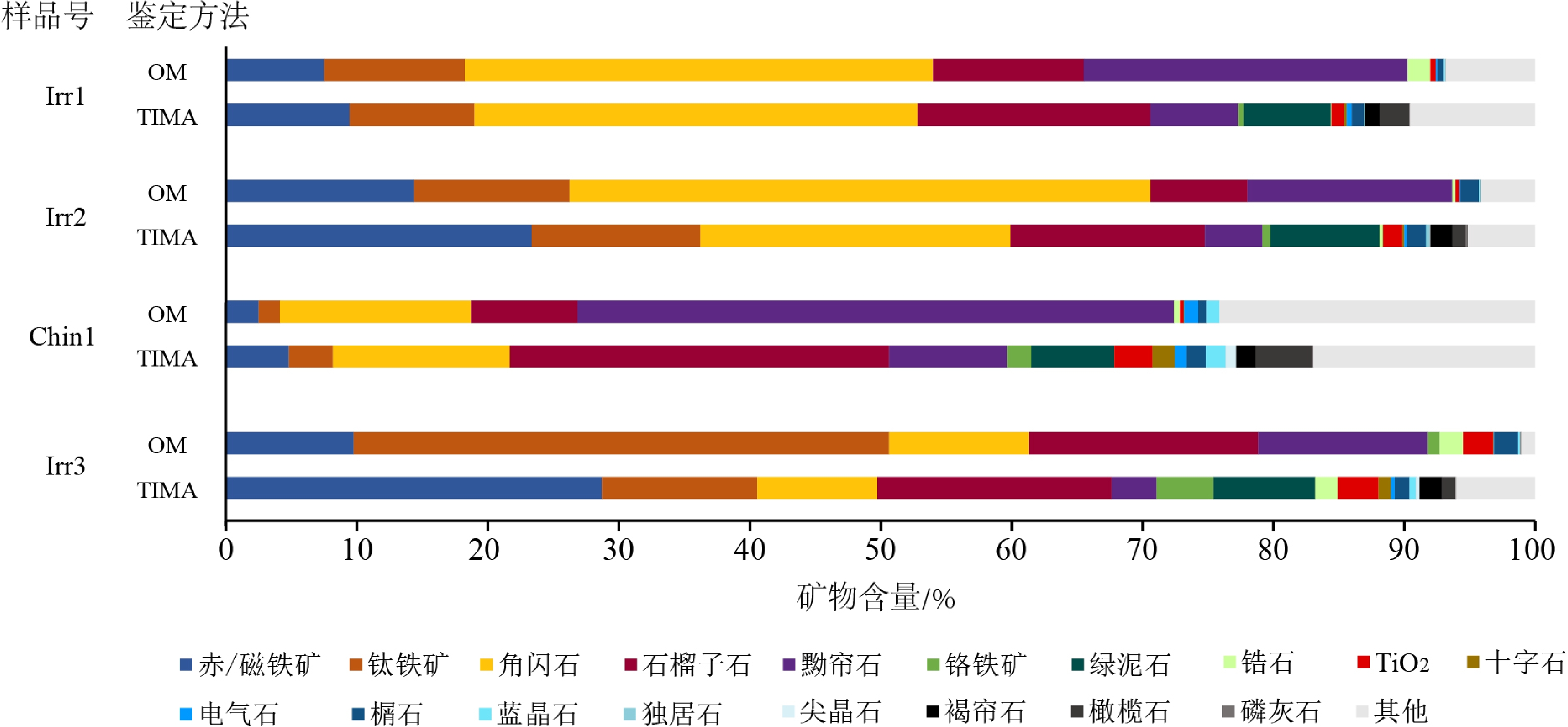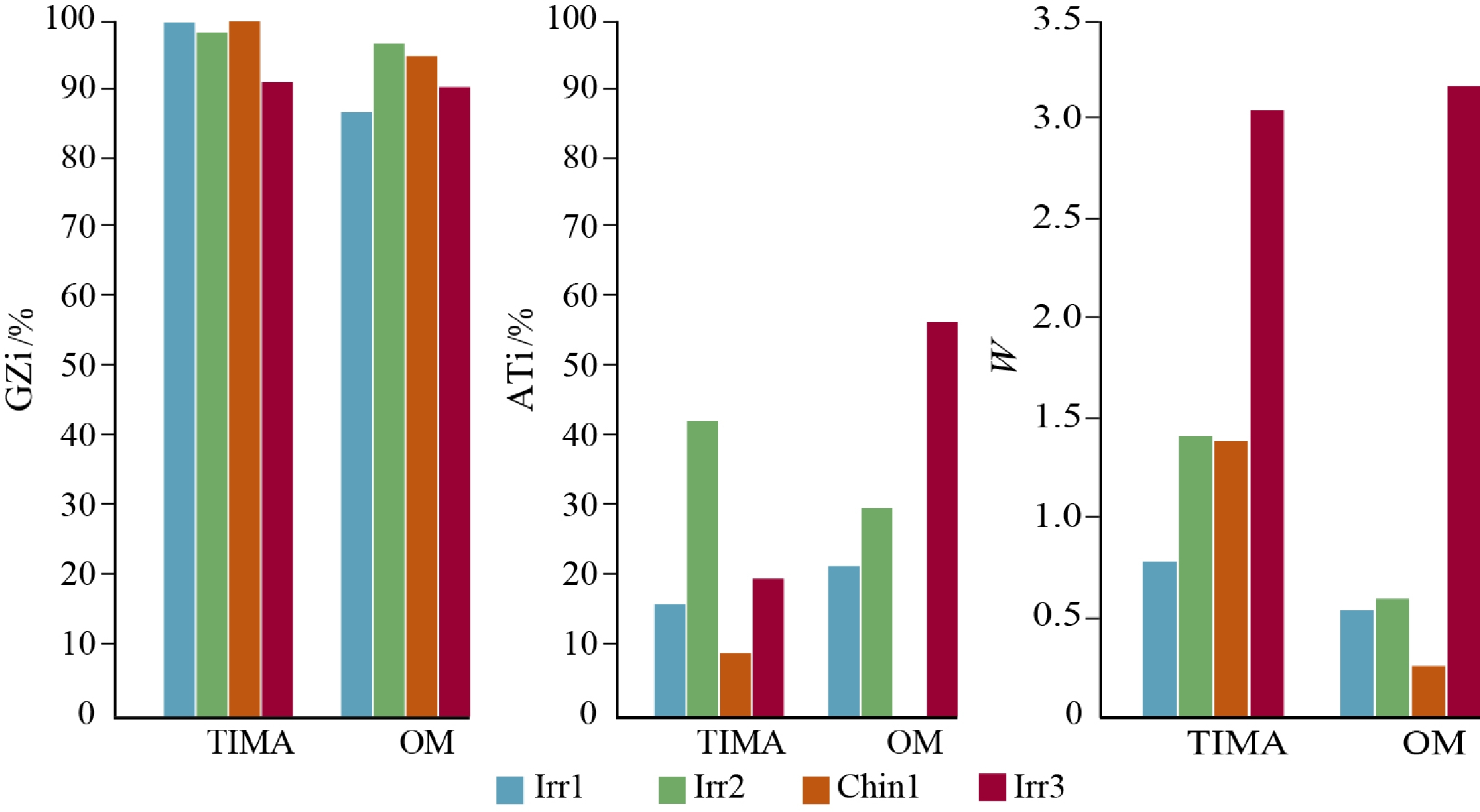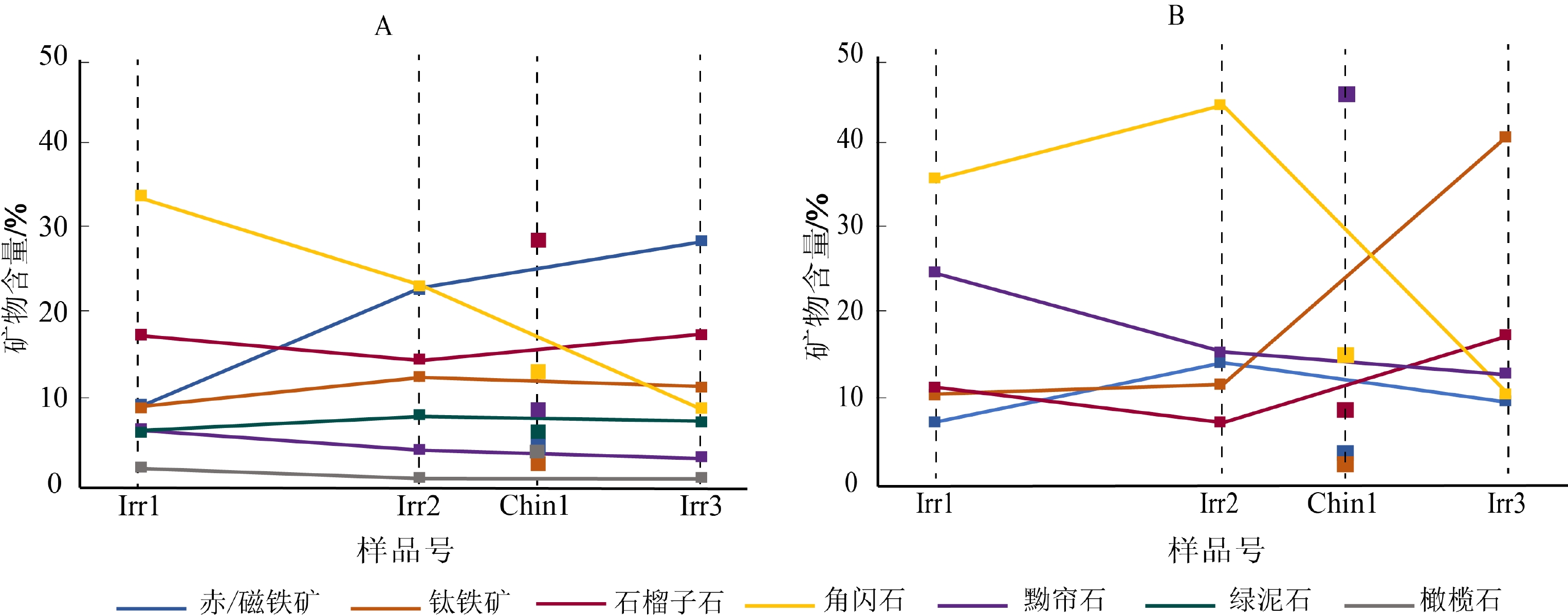Application of two heavy mineral analysis methods in the provenance study of Irrawaddy River sediments on the southeastern margin of Tibetan Plateau
-
摘要: 伊洛瓦底江是亚洲大型河流之一,其沉积物记录了青藏高原周缘造山带的剥蚀风化信息,对该流域沉积物的溯源研究是探究高原隆升对水系演化影响的重要课题。沉积物的重矿物种类与源岩联系紧密,是物源分析的重要手段之一。重矿物鉴定分析手段层出不穷,但不同鉴定手段之间缺乏对比分析。采用自动矿物分析系统TIMA与光学显微镜鉴定(optical microscope, OM)两种方法对伊洛瓦底江沉积物重矿物进行了鉴定分析,结果表明:伊洛瓦底江上游主要重矿物是角闪石-石榴子石-赤/磁铁矿、钛铁矿;伊洛瓦底江下游主要重矿物是赤/磁铁矿、钛铁矿-石榴子石-黝帘石-角闪石;支流钦敦江主要重矿物组合是黝帘石-角闪石-石榴子石。两种方法的结果都指示了伊洛瓦底江沉积物主要来自上游流经的缅甸北部构造单元的变质岩以及中/基性岩,太公-密支那带对伊洛瓦底江沉积物贡献量最大,钦敦江流域对伊洛瓦底江下游沉积物贡献量有限。但是两种方法对重矿物种类以及单个重矿物含量鉴定结果有着明显差异:TIMA方法的鉴定种类更加丰富,且其分析结果与伊洛瓦底江流域地质岩性分布的耦合程度更高,但TIMA无法区分化学性质相同的矿物;OM法对光学性质相近的矿物鉴定结果不准确。因此建议对重矿物分类程度或精确性要求更高的研究使用TIMA进行精确分析,同时辅助OM法区分化学性质相同的矿物。Abstract: The Irrawaddy River is one of the large rivers in Asia, and its sediments record the denudation and weathering information of the orogenic belt around the Tibetan Plateau. Tracing the sediments in this basin is an important topic to explore the impact of plateau uplift on the evolution of river system. The types of heavy minerals in sediments are closely related to source rocks, which is one of the important means for provenance analysis. There are a variety of methods to identify and analyze heavy minerals, but there is a lack of comparative analysis among different methods. This paper adopted TESCAN Integrated Mineral Analyzer (TIMA) and Optical Microscope (OM) to identify and analyze heavy minerals of Irrawaddy River sediments. The main heavy minerals in the upper reaches of the Irrawaddy are amphibole-garnet- hematite/magnetite, ilmenite. The main heavy minerals in the lower reaches of the Irrawaddy are hematite/magnetite, ilmenite-garnet-zoisite-hornblende. The main heavy mineral combination of the tributary Chindwin River is zoisite-hornblende-garnet. The results of both methods indicate that the Irrawaddy sediments are mainly derived from metamorphic and intermediate or mafic rocks of tectonic units in northern Myanmar, with the Tagaung-Myitkyina Belt contributing the most to the Irrawaddy sediments and the Chindwin River basin contributing a limited amount to the lower reaches of the Irrawaddy sediments. However, there are significant differences in the identification results of heavy mineral species and individual heavy mineral contents between the two methods. The identification species of TIMA method are more abundant, and its analysis results are more coupled with the geological lithological distribution of Irrawaddy River basin. It’s also found that TIMA cannot distinguish the minerals with the same chemical properties, and OM method is not accurate in identifying the minerals with similar optical properties. Therefore, it is promoted in this paper that TIMA should be used for accurate analysis in studies requiring more precise and accurate classification of heavy minerals, while the OM method should be supplemented to distinguish minerals with the same chemical properties.
-
Keywords:
- TIMA /
- optical microscope /
- heavy minerals source analysis /
- Irrawaddy River /
- Tibetan Plateau
-
新生代青藏高原的隆升造就了亚洲众多大江大河的发育[1-2],河流作为构造与气候共同作用的产物,是陆源碎屑物质搬运入海的主要方式[3]。位于青藏高原东南缘的伊洛瓦底江发源于西藏察隅县境内,向南流经缅中盆地,携带大量物质汇入安达曼海,是研究青藏高原隆升、季风气候以及亚洲大型河流演化相互关系的关键区域[2,4]。目前对于伊洛瓦底江的演化历史仍存在较大争议,主要表现在:有学者发现缅中盆地始新世—中新世地层沉积物特征与藏南冈底斯弧具有很强的亲缘性[5-6],认为新生代早期伊洛瓦底江曾与雅鲁藏布江连接[1-2];而另一种观点则认为新生代不存在雅鲁藏布江-伊洛瓦底江的连接[7-9]。Licht等认为新生代早期伊洛瓦底江自东向西流入孟加拉湾,缅中盆地物源可能为盆内西缅弧带的近源输入,随着渐新世印缅山脉隆升,伊洛瓦底江流向变为自北向南,缅甸北部构造单元沉积物进入缅中盆地沉积[10]。Clark等的袭夺模型还将伊洛瓦底江作为古红河水系的一部分[1];而Hoang等通过对红河沉积物Hf 同位素的研究,认为伊洛瓦底江不属于古红河水系[11]。目前对伊洛瓦底江沉积物的物源研究相对薄弱,Garzanti 等对伊洛瓦底江进行了物源示踪及沉积物通量估算研究,提出支流钦敦江流域与伊洛瓦底江上游对伊洛瓦底江干流具有基本对等的沉积物贡献比例[12],但Licht等的岩相学、地球化学数据指示伊洛瓦底江上游的缅甸北部构造单元对流域沉积物贡献更重要[7]。可见,伊洛瓦底江的沉积物特征仍需要进一步的研究,这对认识流域演化历史具有重要意义。
沉积物物源示踪作为盆地分析的重要内容,是进行古地理重建、古环境与古气候恢复、盆地分析、构造背景追溯及盆山耦合研究的重要方法和手段[13]。根据研究区沉积物的物质组成、结构等性质推测物源区的母岩类型,可以帮助了解其潜在物源区物质搬运过程以及地形演化[14]。重矿物含量及其组合分析是物源示踪方法的重要手段之一。重矿物在沉积物中通常只占约1%,但其种类丰富,与源岩类型密切相关[14]。根据沉积物中重矿物的含量及组合特征的变化趋势可以分析其母岩类型,追溯沉积物搬运路径,重建古河道,绘制泥砂扩散模式图,阐明成岩作用过程[15]。重矿物特征指数RZi(TiO2矿物-锆石指数)、ATi(磷灰石-电气石指数)、GZi(石榴子石-锆石指数)及W(稳定系数)等能反映沉积物风化程度、物源变化情况以及沉积物搬运距离等[16-18]。
重矿物分析的传统方法是研究者通过光学显微镜(optical microscope, OM)对矿物的光学特性(颜色、多色性、干涉色及双折射率等)和形态特征(突起、晶形及解理等)等进行分析[19-20]。自20世纪70年代开始,扫描电镜(SEM)搭载能谱探测器(EDX),并结合计算机图形和数据处理软件技术被广泛应用在重矿物定量化分析上[21]。目前,全球市场开发的全自动矿物分析系统主要有QEMSCAN、MAPS、AMICS和TIMA等主要厂商和型号[22],其中,TIMA(TESCAN Integrated Mineral Analyzer)系统结合了全自动矿物识别系统高度集成硬件和软件,基于扫描电镜(SEM)及能谱探测器(EDX)能同时进行极高分辨率的背散射与X射线能谱快速成像,通过专业的矿物分析软件系统确定矿物成分。TIMA系统独特的低计数谱图拟合算法能进行高精度的矿物识别,对低含量矿物具有较高的检测灵敏度[23]。传统的光学显微镜鉴定和新兴的自动矿物识别系统都被广泛用于矿物鉴定,然而,István Dunkla等用多个实验室的光学显微镜人工鉴定以及SEM-EDX自动化定量矿物识别方法对同一批重矿物进行鉴定,发现两种方法的鉴定结果存在差异[24]。崔颖颖等也发现QEMSCAN分析法与光学显微镜人工鉴定测得的毛乌素沙地单个矿物含量和矿物分析指标存在一定差异[25]。因此,两类重矿物鉴定方法之间的结果对比对于建立统一的重矿物分析标准十分重要。
鉴于此,本文将同时采用自动化矿物鉴别系统TIMA与人工光学显微镜鉴定这两种方法来对比分析伊洛瓦底江的沉积物重矿物特征,判别沉积物的物源变化,并比较两种方法在研究伊洛瓦底江沉积物物源分析上的差异。
1. 研究区概况
伊洛瓦底江流域位于缅甸境内(15°30'~28°50'N、93°16'~98°42'E),全长2714 km,流域面积约为41万km2[26],年均输水量达379±47 km3,年均悬移质通量约为(325±57)×106 t[27]。
伊洛瓦底江的河源有两支(图1),东源恩梅开江发源于中国西藏察隅县境内的伯舒拉岭山脉西南麓,西源迈立开江发源于缅甸北部山区,两江在密松市汇合后始称伊洛瓦底江[29]。伊洛瓦底江右侧支流主要有北部大盈江、瑞丽江及南部的密埃河,左侧支流主要有穆河、钦敦江。钦敦江是伊洛瓦底江最大的支流,长约1046 km,流域面积约11.5万km2,年均输水量约165 km3,其水系切入缅甸中部白垩纪—新生代弧前盆地,沿着印缅山脉东侧向南流动,汇入伊洛瓦底江[30-31]。伊洛瓦底江以与钦敦江的汇合点为界,分为上游和下游。
![]() 图 1 伊洛瓦底江流域地形以及主要构造单元分布图A:伊洛瓦底江流域地形图,B:伊洛瓦底江流域主要构造单元分布图(据Mitchell, 2007[28]和缅甸1∶100万地质图)。Figure 1. The topography and the distribution of major tectonic units in Irrawaddy River BasinA: The topography in Irrawaddy River Basin, B: the distribution of major tectonic units in Irrawaddy River Basin.
图 1 伊洛瓦底江流域地形以及主要构造单元分布图A:伊洛瓦底江流域地形图,B:伊洛瓦底江流域主要构造单元分布图(据Mitchell, 2007[28]和缅甸1∶100万地质图)。Figure 1. The topography and the distribution of major tectonic units in Irrawaddy River BasinA: The topography in Irrawaddy River Basin, B: the distribution of major tectonic units in Irrawaddy River Basin.伊洛瓦底江源头深入青藏高原东南缘,总体呈南-北向贯穿缅中盆地,汇入安达曼海(图1A)。缅甸北部构造背景复杂,有察隅、波密地块、莫古变质带、太公-密支那带、杰沙-甘高山脉、枯门岭以及硬玉矿隆升区等构造单元(图1B),岩性主要是变质岩以及侵入性花岗岩,其中太公-密支那带分布有蛇绿岩带[28,32-35]。缅中盆地在变质岩基底之上沉积近10 km的晚白垩纪、新生代沉积岩,盆地中央分布着白垩纪—第四纪岩浆岩[36]。盆地东侧的掸邦高原沉积了古生代到中生代的地层,广泛分布着碳酸盐岩、页岩等沉积岩[37-38]。盆地西侧印缅山脉的东西两侧岩性不同,山脉东侧主要是蛇绿岩、变质岩及复理岩,山脉西侧主要是复理岩、泥岩、石灰岩等沉积岩[39-41]。
2. 样品和方法
2.1 样品描述
本文选取伊洛瓦底江及其支流钦敦江的边滩、河漫滩沉积物作为研究对象,共采集 4个样品(表1)。其中样品Irr1、Irr2位于伊洛瓦底江干流上游密支那-曼德勒河段,用以分析上游沉积物重矿物信息;样品Chin1位于钦敦江的下游河段,代表了钦敦江流域的沉积物信息;样品Irr3位于伊洛瓦底江下游,代表了来自流域上游和支流钦敦江的物质混合,用以判断支流和干流汇合后干流沉积物重矿物特征变化。所采集样品均为分选良好的砂质沉积物,每个样品取1 kg左右。为了使样品具有代表性,在同一个采样点会采集多处样品以确保其充分混合,采样位置尽量避开城市和可能的污染源。
表 1 伊洛瓦底江沉积物样品信息Table 1. Sample information of Irrawaddy sediments样品号 纬度(N) 经度(E) 样品量/g 重矿物/mg 重矿物占比/% Irr1 23°51'25.03'' 96°13'49.00'' 900 21814 2.42 Irr2 22°26'42.23'' 96°1'00.23'' 1350 58694 4.35 Irr3 20°08'59.83'' 94°53'32.46'' 500 11747 2.35 Chin1 22°11'43.27'' 95°04'27.83'' 1100 5088 0.46 2.2 研究方法
2.2.1 重矿物分离
伊洛瓦底江流域沉积物重矿物的挑选在河北省廊坊市河北区域地质矿产调查研究所实验室完成,主要实验流程如下:
(1)称重:将样品烘干进行称重,记录原始质量。
(2)淘洗:将称取的样品进行粗淘。
(3)重矿物分离:用三溴甲烷(密度为2.89 g/cm3)进行分离,重液下的为重矿物,待用酒精冲洗干净后,烘干称重,记录重矿物部分质量。
2.2.2 光学显微镜重矿物分析
(1)磁选:灰色精砂通过强磁选、电磁选分离出强磁性(如磁铁矿等)、电磁性(角闪石、石榴子石、辉石、橄榄石、电气石、榍石等)及无磁性(锆石、磷灰石、独居石等)三部分,分别记录三部分重矿物质量。
(2)镜下鉴定:对每个组分的重矿物进行镜下挑纯,将特定组分颗粒平摊在玻璃板上,划分4—5个视域,每个视域选取100~150个颗粒,根据每种重矿物体积百分含量计算重矿物质量百分含量。对于含量偏低的重矿物,由于数量级太低无法计算质量百分含量,则只统计颗粒数。
2.2.3 TIMA重矿物分析
(1)制靶与喷碳
将环氧树脂灌注于特定尺寸的PVC环中,倒入与OM鉴定使用的同一批前处理分离的重矿物颗粒,用玻璃棒搅拌使颗粒均匀分布,制成样品靶;经过磨抛使样品靶的高度满足扫描电镜进样标准,且需使样品颗粒充分暴露以便于扫描及拍照;最后将样品靶放入喷碳仪中进行喷碳处理。
(2)扫描与分析
将镀有碳膜的样品放入TESCAN MIRA3场发射扫描电镜中,使用 TIMA 软件进行校准、对焦。工作条件为:电压为25 kV,电流为9.38 nA,束斑大小为82.87 nm,工作距离15.0 mm,扫描模式为RESOLUTION,Pixel size为2 µm,每个样品扫描颗粒数大于1500,待扫描完成后利用分析软件进行数据处理以获得每种矿物的质量百分含量 。
3. 结果与讨论
3.1 重矿物种类统计
TIMA重矿物自动鉴定(下文简称TIMA)与光学显微镜人工鉴定(下文简称OM)两种方法均显示伊洛瓦底江流域沉积物重矿物种类丰富,且不同样品之间存在显著区别(表2)。两种方法得到的结果存在明显差异:TIMA分析识别出包括普通角闪石、阳起石、韭闪石、钙铝榴石、铁铝榴石、镁铝榴石、锰铝榴石、钙铁榴石、赤/磁铁矿、铬铁矿、钛铁矿、绿泥石、黝帘石、褐帘石、橄榄石、锆石、电气石等31种重矿物(图2),而OM方法仅鉴定出包括角闪石、石榴子石、黝帘石、赤铁矿、磁铁矿、钛铁矿、锆石、金红石、锐钛矿、白钛石、榍石、磷灰石、蓝晶石等19种重矿物;OM法没有区分出角闪石族的普通角闪石、阳起石、韭闪石,石榴子石族的钙铝榴石、镁铝榴石、铁铝榴石、锰铝榴石及钙铁榴石,且OM法无法检测含量极少的重矿物,如白云母、黑云母、钡锰闪叶石、刚玉、方铁锰矿、重晶石、霓石等,对重量太低的重矿物也只能进行颗粒数统计,无法统计其质量百分数,如十字石、独居石、尖晶石、辉石等;TIMA没有测出锐钛矿和白钛石,也无法区分赤铁矿和磁铁矿。
表 2 TIMA及OM法测得的伊洛瓦底江沉积物重矿物含量Table 2. Heavy mineral content of Irrawaddy River sediments by TIMA and OM methods% 矿物名称
Irr1
Irr2
Chin1
Irr3TIMA OM TIMA OM TIMA OM TIMA OM 角闪石 / 35.75 / 44.35 / 14.60 / 10.68 普通角闪石 21.45 / 16.23 / 6.68 / 6.03 / 韭闪石 2.55 / 1.75 / 1.51 / 1.09 / 阳起石 9.88 / 5.70 / 5.32 / 2.04 / 赤铁矿 / 1.54 / 5.20 / 0.81 / 0.82 磁铁矿 / 5.98 / 9.19 / 1.70 / 8.94 赤/磁铁矿 9.48 / 23.36 / 4.79 / 28.74 / 钛铁矿 9.49 10.75 12.88 11.88 3.38 1.62 11.83 40.90 铬铁矿 0.42 — 0.61 — 1.84 △ 4.34 0.87 石榴子石 / 11.52 / 7.42 / 8.11 / 17.53 钙铝榴石 13.42 / 10.23 / 23.89 / 10.59 / 铁铝榴石 3.60 / 4.06 / 3.77 / 6.11 / 钙铁榴石 0.40 / 0.19 / 0.90 / 0.67 / 锰铝榴石 0.12 / 0.21 / 0.29 / 0.45 / 镁铝榴石 0.24 / 0.19 / 0.15 / 0.11 / 黝帘石 6.69 24.74 4.38 15.64 9.02 45.60 3.41 12.96 褐帘石 1.13 / 1.66 / 1.47 / 1.70 / 锆石 0.03 1.73 0.25 0.25 0.01 0.43 1.73 1.84 金红石 0.98 0.41 1.49 0.29 2.92 0.27 3.09 1.46 锐钛矿 / — / 0.02 / 0.02 / 0.57 白钛石 / — / — / 0.01 / 0.22 榍石 0.96 0.46 1.47 1.42 1.48 0.64 1.13 1.81 绿泥石 6.68 / 8.34 / 6.33 / 7.8 / 橄榄石 2.26 / 1.07 / 4.31 / 1.04 / 磷灰石 0.08 0.04 0.16 0.03 0.09 — 0.07 0.06 十字石 0.17 △ 0.15 — 1.74 0.05 0.96 0.05 电气石 0.39 0.14 0.22 0.07 0.88 1.06 0.29 0.05 蓝晶石 0.03 0.05 0.05 0.06 1.48 0.97 0.50 0.19 独居石 0.02 0.07 0.22 0.04 0.01 △ 0.00 △ 尖晶石 — △ 0.04 △ 0.83 * 0.25 △ 辉石 / △ / △ / △ / △ 白云母 0.59 / 0.28 / 0.50 / 0.14 / 黑云母 0.33 / 0.10 / 0.03 / 0.02 / 钡锰闪叶石 — / — / 0.08 / — / 刚玉 — / — / 0.07 / — / 方铁锰矿 — / — / 0.04 / — / 重晶石 — / — / — / 0.05 / 霓石 — / 0.03 / — / — / 其他 8.62 6.81 4.68 3.32 16.22 24.09 5.81 1.04 注:“—”表示矿物含量小于0.01%;“/”表示未发现该矿物;“△”代表0~500粒;“*”代表500~700粒;OM指光学显微镜法。 由于TIMA与OM法的分析结果存在以上统计差异,为了进行沉积物物源判别分析,将两种分析方法的重矿物种类进行统一(表3),赤铁矿、磁铁矿统一为赤/磁铁矿;金红石、锐钛矿、白钛石都是以TiO2为主要成分的矿物,将三者统一为TiO2类矿物;钙铝榴石、镁铝榴石、铁铝榴石、锰铝榴石、钙铁榴石统一为石榴子石。此外,含量极少且不常见的重矿物赋含的物源示踪信息有限,不参与物源分析的讨论。
表 3 TIMA与OM法鉴定的伊洛瓦底江沉积物重矿物统一分类Table 3. Unified classification of heavy mineral identification of Irrawaddy River sediments by TIMA and OM methods% 矿物种类
Irr1
Irr2
Chin1
Irr3TIMA OM TIMA OM TIMA OM TIMA OM 稳定
重矿物赤/磁铁矿 9.48 7.52 23.36 14.39 4.79 2.51 28.74 9.76 钛铁矿 9.49 10.75 12.88 11.88 3.38 1.62 11.83 40.90 铬铁矿 0.42 — 0.61 — 1.84 △ 4.34 0.87 石榴子石 17.78 11.52 14.87 7.42 28.98 8.11 17.94 17.53 锆石 0.03 1.73 0.25 0.25 0.01 0.43 1.73 1.84 TiO2 0.98 0.41 1.49 0.31 2.92 0.30 3.09 2.25 十字石 0.17 △ 0.15 — 1.74 0.05 0.96 0.05 电气石 0.39 0.14 0.22 0.07 0.88 1.06 0.29 0.05 榍石 0.96 0.46 1.47 1.42 1.48 0.64 1.13 1.81 蓝晶石 0.03 0.05 0.05 0.06 1.48 0.97 0.50 0.19 独居石 0.02 0.07 0.22 0.04 0.01 △ 0.00 △ 尖晶石 — △ 0.04 △ 0.83 * 0.25 △ 不稳定
重矿物角闪石 33.88 35.75 23.68 44.35 13.51 14.60 9.16 10.68 黝帘石 6.69 24.74 4.38 15.64 9.02 45.60 3.41 12.96 褐帘石 1.13 / 1.66 / 1.47 / 1.70 / 绿泥石 6.68 / 8.34 / 6.33 / 7.8 / 橄榄石 2.26 / 1.07 / 4.31 / 1.04 / 磷灰石 0.08 0.04 0.16 0.03 0.09 — 0.07 0.06 注:“—”表示矿物含量小于0.01%;“/”表示未发现该矿物;“△”代表0~500粒;“*”代表500~700粒;OM指光学显微镜法。 碎屑沉积物中重矿物总体分布特征受到母岩性质、水动力条件和搬运距离的影响[17]。根据重矿物抗风化能力不同,可将重矿物划分为稳定和不稳定两类,稳定重矿物抗风化能力强,搬运距离远,在远离源区的沉积岩中含量仍然较高;不稳定重矿物抗风化能力弱,离源区越远其相对含量越少[18]。伊洛瓦底江流域沉积物样品中稳定重矿物包括锆石、电气石、TiO2矿物、铬铁矿、尖晶石、石榴子石、赤/磁铁矿、榍石、蓝晶石、独居石、钛铁矿、十字石,不稳定重矿物包括磷灰石、褐帘石、黝帘石、橄榄石、角闪石、绿泥石(表3)。
3.2 重矿物组合特征
(1)伊洛瓦底江上游重矿物组合特征
TIMA的分析结果指示伊洛瓦底江上游沉积物主要重矿物组合是角闪石-石榴子石-赤/磁铁矿、钛铁矿,特征重矿物是角闪石(图3);样品Irr2相对于Irr1来说,磁性矿物(赤/磁铁矿、钛铁矿)、绿泥石含量增加,石榴子石以及角闪石含量减少。OM法鉴定结果与TIMA类似,区别在于沉积物中石榴子石的含量少于黝帘石,而且没有绿泥石、橄榄石、铬铁矿以及褐帘石等4种重矿物。
(2)钦敦江重矿物组合特征
钦敦江沉积物重矿物特征与伊洛瓦底江上游存在显著差异,两种鉴定方法都表明钦敦江主要重矿物为黝帘石、角闪石以及石榴子石(图3)。与伊洛瓦底江上游样品相比,钦敦江沉积物中的黝帘石、电气石、蓝晶石含量更高,磁性矿物(赤/磁铁矿、钛铁矿)以及角闪石的含量更低。然而,TIMA中测得钦敦江沉积物中含量最高的重矿物是石榴子石(28.98%),OM法的结果则指示黝帘石含量最高(45.60%),OM法在钦敦江沉积物中没有发现褐帘石、橄榄石以及绿泥石(表3)。
(3)伊洛瓦底江下游重矿物组合特征
伊洛瓦底江下游沉积物以稳定重矿物为主,不稳定重矿物含量明显减少(图3)。TIMA和OM方法均表明伊洛瓦底江下游样品的重矿物组合为磁性矿物(赤/磁铁矿、钛铁矿)、石榴子石、黝帘石以及角闪石。TIMA分析发现沉积物中赤/磁铁矿含量最高(28.74%),而OM法分析发现沉积物中含量最高的重矿物是钛铁矿(40.90%)。此外,TIMA测得的铬铁矿含量高于OM法的结果,但是黝帘石含量则明显低于OM法的结果,且TIMA鉴定出了沉积物中的褐帘石、绿泥石以及橄榄石这三种重矿物(表3)。
3.3 重矿物特征指数
由于重矿物在运输过程中会受到水动力分选、风化以及成岩作用的影响,Morton和Hallsworth等选择了水力学性质接近的稳定重矿物含量比值来揭示沉积物的物源信息及其受风化影响程度[17],这些比值被称为重矿物特征指数,包括ATi指数、GZi指数、稳定系数W等。ATi指数能够揭示沉积物中酸性岩浆岩的物源变化及沉积物受风化程度[16]。GZi指数可反映沉积物的成熟度及其以石榴子石为母岩的物源变化情况。此外,稳定系数W指的是稳定重矿物与不稳定重矿物百分含量的比值,用以反映沉积物的搬运距离[16,18]。重矿物典型特征指数计算方法如下:
$$\rm {ATi}={100}\times\frac{\text{磷灰石}\text{%}}{\text{磷灰石}\text{%}\text+\text{电气石}\text{%}} $$ $$ \text{GZi}\text=\text{100}\text{×}\frac{\text{石榴子石}\text{%}}{\text{石榴子石}\text{%}\text+\text{锆石}\text{%}} $$ $$ {W}\text=\frac{\text{稳定重矿物}\text{%}}{\text{不稳定重矿物}\text{%}} $$ 图4显示伊洛瓦底江干流稳定系数W从上游到下游呈现逐渐增大的变化趋势,指示上游沉积物多为近源输入,下游沉积物多来自远源。沉积物随着搬运距离的增加,不稳定重矿物含量减少,稳定重矿物相对富集。GZi指数在整个流域范围内均普遍偏高,空间变率较小,表明流域沉积物中以石榴子石为主的母岩贡献量较大;ATi指数总体偏低,支流钦敦江ATi指数最低,说明流域沉积物中酸性岩浆岩的物源输入较少,或沉积物受风化程度较高。
TIMA和OM两种方法计算的重矿物特征指数亦存在显著差异:TIMA测得的钦敦江沉积物稳定系数W大于1,而OM法得到的钦敦江稳定系数W偏低;OM法测得的钦敦江沉积物ATi指数为0,而其测得伊洛瓦底江下游沉积物ATi指数远高于TIMA。Garzanti等利用化学蚀变指数(CIA)评估伊洛瓦底江流域沉积物风化程度时发现,伊洛瓦底江上游沉积物风化程度最低,钦敦江沉积物风化程度最高[12],该结论与TIMA分析中计算的ATi指数变化一致。OM法分析结果显示伊洛瓦底江下游ATi指数最高(图4),可能受到了该方法鉴定的过低电气石含量的影响。
3.4 沉积物物源分析
不同的母岩类型会产生不同的矿物种类,这是运用重矿物进行溯源研究的原理[14]:大量晶形完好的锆石、电气石、磷灰石等矿物组合指示源区中酸性岩浆岩的存在;石榴子石、绿帘石、绿泥石主要是变质成因;大量的赤/磁铁矿、钛铁矿、角闪石以及橄榄石、辉石的出现说明基性火成岩的存在;沉积岩母岩被风化搬运后会形成大量粒状的白钛石、滚圆的锆石以及少量的金红石[42]。
伊洛瓦底江上游的主要重矿物是角闪石-石榴子石-赤/磁铁矿、钛铁矿,表明其主要的物源供给是变质岩及中/基性岩,偏高的GZi指数表明以石榴子石为母岩的变质岩贡献较大,ATi指数偏低则说明中/酸性岩浆岩的贡献量较小。伊洛瓦底江上游沉积物主要来自缅甸北部构造单元,其中莫古变质带和波密、察隅地块大面积分布中高级变质岩石榴子石片岩/片麻岩、角闪石片岩[43](图1),为流域上游沉积物提供较高含量的石榴子石、黝帘石和角闪石;杰沙-甘高山脉东侧小范围分布绿泥石片岩以及绢云母片岩等低级变质岩[33](图1),为上游沉积物贡献了较高含量的绿泥石;大面积绿泥石-绿帘石片岩及蛇绿岩覆盖太公密支那带[32](图1),片岩向伊洛瓦底江贡献绿泥石、黝帘石等矿物,蛇绿岩带以橄榄岩、辉长岩、辉绿岩以及枕状玄武岩等基性、超基性岩为主,剥蚀了大量的角闪石、磁性矿物(赤/磁铁矿、钛铁矿)等矿物进入伊洛瓦底江,使得其橄榄石、铬铁矿含量略高。
支流钦敦江源自枯门岭西侧,流经硬玉矿抬升区后与印缅山脉平行向南流动,下游流向在葛礼瓦城转向东南,穿过缅甸中央岩浆弧后汇入伊洛瓦底江(图1)。枯门岭西南部新生代砾岩之下暴露大面积石英-绿泥石-绿帘石片岩[44],山脉西侧分布有高压变质岩榴辉岩[45]。印缅山脉东翼的变质岩类型主要是滑石片岩、云母片岩、绿泥石-绿帘石片岩[39]。变质岩的剥蚀风化为钦敦江沉积物提供了石榴子石、黝帘石以及绿泥石等变质矿物,偏高的GZi指数也指示了变质岩的大量贡献。除变质岩外,蛇绿岩带的分布范围涵盖了整个印缅山脉,蒙育瓦城市附近的钦敦江河谷两侧出露大面积的玄武岩,部分区域的花岗岩侵入玄武岩中[46](图1)。钦敦江沉积物中的橄榄石以及铬铁矿即为蛇绿岩带的岩体风化后搬运到钦敦江沉积,角闪石、赤/磁铁矿、钛铁矿等则可能来自于中央岩浆弧的玄武岩熔岩或蛇绿岩带的中/基性岩。TIMA分析计算的稳定系数W较大,指示钦敦江样品沉积物主要来自于远源,故而TIMA的重矿物组合指示物源以上游变质岩为主,近源的岩浆岩来源有限,ATi指数偏低。而OM法计算的稳定系数W较小,指示钦敦江样品沉积物主要以近源岩浆岩供给为主,这与重矿物组合中变质岩含量过半以及ATi指数为零的现象相矛盾。
伊洛瓦底江下游在钦敦江汇入后,继续向南流经缅甸中央沉积盆地,汇入安达曼海(图1)。下游重矿物主要为稳定重矿物,重矿物稳定系数W较高,指示下游沉积物搬运距离较远。赤/磁铁矿、钛铁矿都是铁矿床中常见的矿物,缅甸铁矿资源主要产于晚古生代和中生代灰岩和白云质灰岩上部或古近纪基性和超基性岩表层,矿石成分以赤/磁铁矿、针铁矿为主,该类型矿床主要分布在密支那西北部[47](图1)。伊洛瓦底江上游以及钦敦江流域钛铁矿范围有限,且伊洛瓦底江下游和其他支流没有流经大型铁矿床。因此,TIMA鉴定结果更符合磁性重矿物含量分布,下游的钛铁矿含量中等,磁性重矿物含量集中在赤/磁铁矿。此外,流域下游流经新生代沉积地层,可认为沉积物中石榴子石、黝帘石以及绿泥石等矿物主要来自于上游或者钦敦江的变质岩分布区域;铬铁矿、橄榄石及角闪石主要来自于上游或者钦敦江的蛇绿岩带。伊洛瓦底江下游的锆石以及TiO2矿物含量在TIMA的鉴定结果中明显增高,指示TiO2矿物主要来自钦敦江。伊洛瓦底江上游以及钦敦江的锆石含量都较低,推测下游较高含量的锆石可能来自于伊洛瓦底江其他支流。其中穆河发源于大面积的花岗岩分布区域(图1),推测下游较高的锆石含量可能来自于该河源头侵蚀。
Amidon等在评估不同源区对喜马拉雅河流系统的锆石贡献量时指出,不同源区的两个具有良好特征的年龄群体在下游混合成第三个群体时,下游年龄信号具有上游不同源区混合年龄特征[48]。在利用重矿物进行物源分析时,同样可以设想当支流的重矿物组分与干流有明显差异时,河流的重矿物组成将在汇合处下游发生显著变化。图5展示了两种方法分析的重矿物含量在伊洛瓦底江干流以及钦敦江变化情况,折线表示干流主要重矿物含量变化,散点表示钦敦江主要重矿物含量变化。
![]() 图 5 伊洛瓦底江沉积物主要重矿物含量变化折线图A:TIMA测得伊洛瓦底江主要重矿物变化,B:OM法测得伊洛瓦底江主要重矿物变化。Figure 5. The line chart of changes in heavy mineral content of Irrawaddy River sedimentsA: The major heavy mineral changes of Irrawaddy River sediments by TIMA, B: The major heavy minerals changes of Irrawaddy River sediments by OM.
图 5 伊洛瓦底江沉积物主要重矿物含量变化折线图A:TIMA测得伊洛瓦底江主要重矿物变化,B:OM法测得伊洛瓦底江主要重矿物变化。Figure 5. The line chart of changes in heavy mineral content of Irrawaddy River sedimentsA: The major heavy mineral changes of Irrawaddy River sediments by TIMA, B: The major heavy minerals changes of Irrawaddy River sediments by OM.从TIMA分析结果(图5A)来看,干流的主要重矿物赤/磁铁矿、石榴子石在钦敦江汇入后(Irr2-Irr3)含量上升,钦敦江的石榴子石含量远高于干流,赤/磁铁矿含量较少,说明钦敦江对伊洛瓦底江沉积物中的石榴子石矿物贡献量较大,但是赤/磁铁矿贡献有限。相反,钛铁矿、绿泥石、黝帘石以及橄榄石含量在钦敦江汇入后(Irr2-Irr3)变化不大,尽管钦敦江的黝帘石、橄榄石含量较高,但其对伊洛瓦底江的黝帘石供给量仍然有限,钦敦江的钛铁矿以及绿泥石含量较低,指示钦敦江对伊洛瓦底江沉积物的钛铁矿、绿泥石供给较少。伊洛瓦底江下游(Irr2-Irr3)的角闪石含量大幅降低,而且钦敦江角闪石含量较少,说明钦敦江对伊洛瓦底江的角闪石贡献量较少,钦敦江汇入后稀释了角闪石的含量。同理,OM法鉴定结果(图5B)指示钦敦江对伊洛瓦底江下游的石榴子石以及黝帘石具有有限的贡献量,而角闪石、赤/磁铁矿、钛铁矿贡献量较少。综上,钦敦江除了对伊洛瓦底江下游沉积物中的石榴子石贡献量较大外,对其他主要矿物贡献量有限。
综合两种方法对伊洛瓦底江重矿物鉴定的合理性,钦敦江的沉积物主要来自印缅山脉右翼的变质岩及蛇绿岩,其对伊洛瓦底江沉积物贡献量相对较小。上游流域的缅甸北部构造单元—太公-密支那带、莫古变质带、硬玉矿隆升区以及杰沙-甘高山脉是伊洛瓦底江干流沉积物更重要的物源贡献区,其中贡献量较大的构造单元是分布有大面积变质片岩和蛇绿岩带的太公-密支那带。该结论与Licht等的观点一致[7],但与Garzanti等的研究结果存在差异[12]。这可能与Garzanti 等的研究结果中含有较高含量的辉石及缺失磁性矿物有关,导致其认为伊洛瓦底江源头及钦敦江均具有较高的沉积物贡献量[12],此差异很可能是样品重矿物前处理过程不同引起的。
3.5 TIMA与光学显微镜鉴定重矿物结果对比
光学显微镜与TIMA都是很有意义的重矿物分析方法,从伊洛瓦底江流域沉积物重矿物分析结果可以看出,这两种方法在重矿物分析上有着显著差异。虽然二者都分析出伊洛瓦底江流域沉积物的重矿物源岩主要是变质岩以及中/基性岩浆岩,但是重矿物种类以及单个重矿物含量有着明显差异。
TIMA在伊洛瓦底江沉积物中鉴别出更丰富的重矿物种类,能区分角闪石族以及石榴子石族的变种矿物,而且能够捕捉到含量较少的重矿物的信息。因此,TIMA能够提供较为丰富细致的矿物学参数,更适合应用到特定矿物的搜索研究中。如Xu等利用TIMA分析超硅石榴子石包体,提供了碳酸岩岩浆起源于地幔过渡带的直接证据[49]。然而,TIMA是基于化学成分识别矿物种类并统计含量的方法,对鉴定成分相同或相近的矿物存在困难,如对于化学成分都是TiO2的矿物,TIMA无法区分出金红石、锐钛矿和白钛石,但是重矿物特征指数ZTR(锆石-电气石-金红石指数)以及RuZi(金红石-锆石指数)都要求获得单独金红石矿物的含量,用所有TiO2矿物代替金红石分析会使指数误差增大。此外,TIMA也无法区分赤铁矿与磁铁矿,而是将两种矿物统一记为赤/磁铁矿(表2)。István Dunkl等也发现,SEM-EDX自动化矿物定量分析系统对识别化学成分类似的硅酸类矿物,如辉石类和黏土类矿物,会出现较大误差[24]。因此,对于鉴定化学成分相同的矿物,建议配合光学显微镜等传统矿物鉴定方法联合使用。
光学显微镜法对于光性复杂或者光性重叠的重矿物种类鉴别存在困难[20],角闪石族以及石榴子石族内各种变种矿物之间类质同象现象十分普遍[50],故其无法区分角闪石族中的阳起石、韭闪石、普通角闪石以及同属于石榴子石族的钙铝榴石、铁铝榴石、钙铁榴石、锰铝榴石、钙铁榴石、镁铝榴石。有研究表明变种矿物成分的差异也可分析物源变化,如Morton等根据北海砂岩中石榴子石成分差异,提出了石榴子石AS-P-G端元图(铁铝榴石+锰铝榴石-镁铝榴石-钙铝榴石)来分析其沉积物物源[51]。此外,光学显微镜人工鉴定要求实验人员具备丰富的矿物鉴定经验,不同实验室光学显微镜法对成分相同的人工重矿物样品的鉴定结果往往匹配程度较低,重复性较差[24]。
通过结合伊洛瓦底江流域的地质单元岩性分布情况,TIMA的重矿物分析结果更符合实际情况。整体上,两种方法都说明了伊洛瓦底江沉积物中较大比例变质岩以及中/基性岩浆岩的物源,但TIMA对于磁性矿物(赤/磁铁矿、钛铁矿)以及缅甸蛇绿岩带的标志性矿物橄榄石以及铬铁矿的含量分析更加准确。帘石类以及绿泥石矿物易风化产生蚀变,矿物颗粒表面的颜色、光泽等信息更加复杂,增加了OM鉴定的难度,也对OM法鉴定人员的专业技能要求更高。同时,TIMA基于能谱分析是无法判断矿物蚀变情况的,这可能是这两类矿物含量在两种方法鉴定结果中存在显著差异甚至偏离真实值的原因。但鉴于本文所鉴定的样品为同一批分离过程挑选出来的重矿物,且讨论部分证实了TIMA的结果更加客观可靠,因此,认为TIMA的鉴定结果更为客观,后续研究也将针对此类矿物进行进一步的鉴定分析。
4. 结论
(1)从伊洛瓦底江流域地质岩性分布以及重矿物分析结果的耦合来看,TIMA以及OM法都鉴定出伊洛瓦底江主要重矿物为石榴子石、黝帘石、磁性矿物(赤/磁铁矿、钛铁矿)及角闪石,指示伊洛瓦底江沉积物主要来自缅甸北部构造单元的变质岩以及中基性岩,但TIMA对于磁性矿物(赤/磁铁矿、钛铁矿)以及缅甸蛇绿岩带的标志性矿物橄榄石以及铬铁矿的含量分析更加准确。
(2)伊洛瓦底江沉积物潜在物源区主要有北部莫古变质带、太公-密支那带、杰沙-甘高山脉、枯门岭以及硬玉矿隆升区,缅甸西部的印缅山脉以及中部的岩浆岩带。根据钦敦江汇入后干流重矿物含量变化,本文推测钦敦江对伊洛瓦底江下游沉积物贡献量有限;分布有变质岩以及蛇绿岩带的太公-密支那带对伊洛瓦底江沉积物贡献量最大。
(3)TIMA法与OM法对伊洛瓦底江重矿物特征的分析结果具有明显差异,首先表现在矿物种类上,TIMA检测出更丰富的重矿物种类。OM法对光学性质相近的矿物鉴定结果准确度不高,但变种矿物之间类质同象现象十分普遍。TIMA能对变种矿物进行更为详细的分类分析,但是不能区分化学性质相同的TiO2矿物、赤铁矿与磁铁矿。结合TIMA以及OM法对伊洛瓦底江沉积物分析结果的差异,建议如果要对化学性质有差异但是光学性质相近的矿物进行详细鉴定分析,TIMA的分析结果更加可靠,并且可采用TIMA方法进行特定矿物的详细研究以及全岩矿物和化学组成分析;而对于化学性质相同的矿物则应选择OM法进行区分鉴定。
-
图 1 伊洛瓦底江流域地形以及主要构造单元分布图
A:伊洛瓦底江流域地形图,B:伊洛瓦底江流域主要构造单元分布图(据Mitchell, 2007[28]和缅甸1∶100万地质图)。
Figure 1. The topography and the distribution of major tectonic units in Irrawaddy River Basin
A: The topography in Irrawaddy River Basin, B: the distribution of major tectonic units in Irrawaddy River Basin.
图 5 伊洛瓦底江沉积物主要重矿物含量变化折线图
A:TIMA测得伊洛瓦底江主要重矿物变化,B:OM法测得伊洛瓦底江主要重矿物变化。
Figure 5. The line chart of changes in heavy mineral content of Irrawaddy River sediments
A: The major heavy mineral changes of Irrawaddy River sediments by TIMA, B: The major heavy minerals changes of Irrawaddy River sediments by OM.
表 1 伊洛瓦底江沉积物样品信息
Table 1 Sample information of Irrawaddy sediments
样品号 纬度(N) 经度(E) 样品量/g 重矿物/mg 重矿物占比/% Irr1 23°51'25.03'' 96°13'49.00'' 900 21814 2.42 Irr2 22°26'42.23'' 96°1'00.23'' 1350 58694 4.35 Irr3 20°08'59.83'' 94°53'32.46'' 500 11747 2.35 Chin1 22°11'43.27'' 95°04'27.83'' 1100 5088 0.46 表 2 TIMA及OM法测得的伊洛瓦底江沉积物重矿物含量
Table 2 Heavy mineral content of Irrawaddy River sediments by TIMA and OM methods
% 矿物名称
Irr1
Irr2
Chin1
Irr3TIMA OM TIMA OM TIMA OM TIMA OM 角闪石 / 35.75 / 44.35 / 14.60 / 10.68 普通角闪石 21.45 / 16.23 / 6.68 / 6.03 / 韭闪石 2.55 / 1.75 / 1.51 / 1.09 / 阳起石 9.88 / 5.70 / 5.32 / 2.04 / 赤铁矿 / 1.54 / 5.20 / 0.81 / 0.82 磁铁矿 / 5.98 / 9.19 / 1.70 / 8.94 赤/磁铁矿 9.48 / 23.36 / 4.79 / 28.74 / 钛铁矿 9.49 10.75 12.88 11.88 3.38 1.62 11.83 40.90 铬铁矿 0.42 — 0.61 — 1.84 △ 4.34 0.87 石榴子石 / 11.52 / 7.42 / 8.11 / 17.53 钙铝榴石 13.42 / 10.23 / 23.89 / 10.59 / 铁铝榴石 3.60 / 4.06 / 3.77 / 6.11 / 钙铁榴石 0.40 / 0.19 / 0.90 / 0.67 / 锰铝榴石 0.12 / 0.21 / 0.29 / 0.45 / 镁铝榴石 0.24 / 0.19 / 0.15 / 0.11 / 黝帘石 6.69 24.74 4.38 15.64 9.02 45.60 3.41 12.96 褐帘石 1.13 / 1.66 / 1.47 / 1.70 / 锆石 0.03 1.73 0.25 0.25 0.01 0.43 1.73 1.84 金红石 0.98 0.41 1.49 0.29 2.92 0.27 3.09 1.46 锐钛矿 / — / 0.02 / 0.02 / 0.57 白钛石 / — / — / 0.01 / 0.22 榍石 0.96 0.46 1.47 1.42 1.48 0.64 1.13 1.81 绿泥石 6.68 / 8.34 / 6.33 / 7.8 / 橄榄石 2.26 / 1.07 / 4.31 / 1.04 / 磷灰石 0.08 0.04 0.16 0.03 0.09 — 0.07 0.06 十字石 0.17 △ 0.15 — 1.74 0.05 0.96 0.05 电气石 0.39 0.14 0.22 0.07 0.88 1.06 0.29 0.05 蓝晶石 0.03 0.05 0.05 0.06 1.48 0.97 0.50 0.19 独居石 0.02 0.07 0.22 0.04 0.01 △ 0.00 △ 尖晶石 — △ 0.04 △ 0.83 * 0.25 △ 辉石 / △ / △ / △ / △ 白云母 0.59 / 0.28 / 0.50 / 0.14 / 黑云母 0.33 / 0.10 / 0.03 / 0.02 / 钡锰闪叶石 — / — / 0.08 / — / 刚玉 — / — / 0.07 / — / 方铁锰矿 — / — / 0.04 / — / 重晶石 — / — / — / 0.05 / 霓石 — / 0.03 / — / — / 其他 8.62 6.81 4.68 3.32 16.22 24.09 5.81 1.04 注:“—”表示矿物含量小于0.01%;“/”表示未发现该矿物;“△”代表0~500粒;“*”代表500~700粒;OM指光学显微镜法。 表 3 TIMA与OM法鉴定的伊洛瓦底江沉积物重矿物统一分类
Table 3 Unified classification of heavy mineral identification of Irrawaddy River sediments by TIMA and OM methods
% 矿物种类
Irr1
Irr2
Chin1
Irr3TIMA OM TIMA OM TIMA OM TIMA OM 稳定
重矿物赤/磁铁矿 9.48 7.52 23.36 14.39 4.79 2.51 28.74 9.76 钛铁矿 9.49 10.75 12.88 11.88 3.38 1.62 11.83 40.90 铬铁矿 0.42 — 0.61 — 1.84 △ 4.34 0.87 石榴子石 17.78 11.52 14.87 7.42 28.98 8.11 17.94 17.53 锆石 0.03 1.73 0.25 0.25 0.01 0.43 1.73 1.84 TiO2 0.98 0.41 1.49 0.31 2.92 0.30 3.09 2.25 十字石 0.17 △ 0.15 — 1.74 0.05 0.96 0.05 电气石 0.39 0.14 0.22 0.07 0.88 1.06 0.29 0.05 榍石 0.96 0.46 1.47 1.42 1.48 0.64 1.13 1.81 蓝晶石 0.03 0.05 0.05 0.06 1.48 0.97 0.50 0.19 独居石 0.02 0.07 0.22 0.04 0.01 △ 0.00 △ 尖晶石 — △ 0.04 △ 0.83 * 0.25 △ 不稳定
重矿物角闪石 33.88 35.75 23.68 44.35 13.51 14.60 9.16 10.68 黝帘石 6.69 24.74 4.38 15.64 9.02 45.60 3.41 12.96 褐帘石 1.13 / 1.66 / 1.47 / 1.70 / 绿泥石 6.68 / 8.34 / 6.33 / 7.8 / 橄榄石 2.26 / 1.07 / 4.31 / 1.04 / 磷灰石 0.08 0.04 0.16 0.03 0.09 — 0.07 0.06 注:“—”表示矿物含量小于0.01%;“/”表示未发现该矿物;“△”代表0~500粒;“*”代表500~700粒;OM指光学显微镜法。 -
[1] Clark M K, Schoenbohm L M, Royden L H, et al. Surface uplift, tectonics, and erosion of eastern Tibet from large-scale drainage patterns [J]. Tectonics, 2004, 23(1): TC1006.
[2] Brookfield M E. The evolution of the great river systems of southern Asia during the Cenozoic India-Asia collision: rivers draining southwards [J]. Geomorphology, 1998, 22(3-4): 285-312. doi: 10.1016/S0169-555X(97)00082-2
[3] 郑洪波, 王平, 何梦颖, 等. 长江东流水系建立的时限及其构造地貌意义[J]. 第四纪研究, 2013, 33(4):621-630 doi: 10.3969/j.issn.1001-7410.2013.04.01 ZHENG Hongbo, WANG Ping, HE Mengying, et al. Timing of the establishment of the east-flowing Yangtze River and tectonic-geomorphic implications [J]. Quaternary Sciences, 2013, 33(4): 621-630. doi: 10.3969/j.issn.1001-7410.2013.04.01
[4] Robinson R A J, Bird M I, Oo N W, et al. The irrawaddy river sediment flux to the Indian ocean: the original nineteenth‐century data revisited [J]. The Journal of Geology, 2007, 115(6): 629-640. doi: 10.1086/521607
[5] Robinson R A J, Brezina C A, Parrish R R, et al. Large rivers and orogens: The evolution of the Yarlung Tsangpo-Irrawaddy system and the eastern Himalayan syntaxis [J]. Gondwana Research, 2014, 26(1): 112-121. doi: 10.1016/j.gr.2013.07.002
[6] Liang Y H, Chung S L, Liu D Y, et al. Detrital zircon evidence from Burma for reorganization of the eastern Himalayan river system [J]. American Journal of Science, 2008, 308(4): 618-638. doi: 10.2475/04.2008.08
[7] Licht A, Reisberg L, France-Lanord C, et al. Cenozoic evolution of the central Myanmar drainage system: insights from sediment provenance in the Minbu Sub-Basin [J]. Basin Research, 2016, 28(2): 237-251. doi: 10.1111/bre.12108
[8] Zhang P, Najman Y, Mei L F, et al. Palaeodrainage evolution of the large rivers of East Asia, and Himalayan-Tibet tectonics [J]. Earth-Science Reviews, 2019, 192: 601-630. doi: 10.1016/j.earscirev.2019.02.003
[9] Licht A, France-Lanord C, Reisberg L, et al. A palaeo Tibet-Myanmar connection? Reconstructing the Late Eocene drainage system of central Myanmar using a multi-proxy approach [J]. Journal of the Geological Society, 2013, 170(6): 929-939. doi: 10.1144/jgs2012-126
[10] Licht A, Dupont-Nivet G, Win Z, et al. Paleogene evolution of the Burmese forearc basin and implications for the history of India-Asia convergence [J]. GSA Bulletin, 2019, 131(5-6): 730-748. doi: 10.1130/B35002.1
[11] Van Hoang L, Wu F Y, Clift P D, et al. Evaluating the evolution of the Red River system based on in situ U-Pb dating and Hf isotope analysis of zircons [J]. Geochemistry, Geophysics, Geosystems, 2009, 10(11): Q11008.
[12] Garzanti E, Wang J G, Vezzoli G, et al. Tracing provenance and sediment fluxes in the Irrawaddy River basin (Myanmar) [J]. Chemical Geology, 2016, 440: 73-90. doi: 10.1016/j.chemgeo.2016.06.010
[13] 杨仁超, 李进步, 樊爱萍, 等. 陆源沉积岩物源分析研究进展与发展趋势[J]. 沉积学报, 2013, 31(1):99-107 YANG Renchao, LI Jinbu, FAN Aiping, et al. Research progress and development tendency of provenance analysis on terrigenous sedimentary rocks [J]. Acta Sedimentologica Sinica, 2013, 31(1): 99-107.
[14] Pettijohn F J, Potter P E, Siever R. Sand and Sandstone[M]. New York: Springer, 1972.
[15] Mange M A, Maurer H F W. Heavy Minerals in Colour[M]. London: Chapman and Hall, 1992.
[16] Morton A C, Hallsworth C R. Processes controlling the composition of heavy mineral assemblages in sandstones [J]. Sedimentary Geology, 1999, 124(1-4): 3-29. doi: 10.1016/S0037-0738(98)00118-3
[17] Morton A C, Hallsworth C. Identifying provenance-specific features of detrital heavy mineral assemblages in sandstones [J]. Sedimentary Geology, 1994, 90(3-4): 241-256. doi: 10.1016/0037-0738(94)90041-8
[18] Zuffa G G, Serra F. Chapter 9 effects of hydrothermal fluids on the heavy mineral assemblage of a late pleistocene succession deposited in an oceanic ridge valley (Escanaba trough, Juan De Fuca Plate) [J]. Developments in Sedimentology, 2007, 58: 263-276.
[19] Sylvester P. Quantitative Mineralogy and Microanalysis of Sediments and Sedimentary Rocks[M]. St. John’s NL: Mineralogical Association of Canada, 2012: 25-26.
[20] 任迎新, 朱宝华. 重砂矿物分选及鉴定[M]. 武汉: 中国地质大学出版社, 1987. ZHU Yingxin, ZHU Baohua. Heavy Placer Mineral Separation and Identification[M]. Wuhan: China University of Geosciences, 1987.
[21] Sylvester P J. Use of the Mineral Liberation Analyzer (MLA) for Mineralogical Studies of Sediments and Sedimentary Rocks[M]. St. John’s NL: Mineralogical Association of Canada, 2012: 1-16.
[22] Hrstka T, Gottlieb P, Skála R, et al. Automated mineralogy and petrology - applications of TESCAN Integrated Mineral Analyzer (TIMA) [J]. Journal of Geosciences, 2018, 63(1): 47-63.
[23] 陈倩, 宋文磊, 杨金昆, 等. 矿物自动定量分析系统的基本原理及其在岩矿研究中的应用: 以捷克泰思肯公司TIMA为例[J]. 矿床地质, 2021, 40(2):345-368 CHEN Qian, SONG Wenlei, YANG Jinkun, et al. Principle of automated mineral quantitative analysis system and its application in petrology and mineralogy: An example from TESCAN TIMA [J]. Mineral Deposits, 2021, 40(2): 345-368.
[24] Dunkl I, Von Eynatten H, Andò S, et al. Comparability of heavy mineral data – The first interlaboratory round robin test [J]. Earth-Science Reviews, 2020, 211: 103210. doi: 10.1016/j.earscirev.2020.103210
[25] 崔颖颖, 周亚利, 陈国祥, 等. 毛乌素沙地样品扫描电镜的矿物定量分析[J]. 干旱区地理, 2020, 43(6):1505-1513 CUI Yingying, ZHOU Yali, CHEN Guoxiang, et al. Mineral quantitative analysis of Mu Us Sandy Land with QEMSCAN [J]. Arid Land Geography, 2020, 43(6): 1505-1513.
[26] 刘冬英, 陈玺, 黄燕, 等. 缅甸伊洛瓦底江流域水文资料初步复核评价[J]. 人民长江, 2018, 49(22):112-117 LIU Dongying, CHEN Xi, HUANG Yan, et al. Preliminary recheck and evaluation of hydrological data in Irrawaddy River Basin, Myanmar [J]. Yangtze River, 2018, 49(22): 112-117.
[27] Furuichi T, Win Z, Wasson R J. Discharge and suspended sediment transport in the Ayeyarwady River, Myanmar: centennial and decadal changes [J]. Hydrological Processes, 2010, 23(11): 1631-1641.
[28] Mitchell A H G, Htay M T, Htun K M, et al. Rock relationships in the Mogok metamorphic belt, Tatkon to Mandalay, central Myanmar [J]. Journal of Asian Earth Sciences, 2007, 29(5-6): 891-910. doi: 10.1016/j.jseaes.2006.05.009
[29] 刘锋, 赵越, 宋立才, 等. 伊洛瓦底江上游水系形成时代研究: 以滇西龙川江为例[J]. 中国地质, 2015, 42(1):199-206 doi: 10.3969/j.issn.1000-3657.2015.01.016 LIU Feng, ZHAO Yue, SONG Licai, et al. Time of the upper Irrawaddy streams: A case study of the Longchuan River, western Yunnan [J]. Geology in China, 2015, 42(1): 199-206. doi: 10.3969/j.issn.1000-3657.2015.01.016
[30] Chapman H, Bickle M, Thaw S H, et al. Chemical fluxes from time series sampling of the Irrawaddy and Salween Rivers, Myanmar [J]. Chemical Geology, 2015, 401: 15-27. doi: 10.1016/j.chemgeo.2015.02.012
[31] Zin W W, Nestmann F, Ihringer J. Flood forecasting using FGM model in Chindwin river basin [J]. Malaysian Journal of Civil Engineering, 2009, 21(2): 135-151.
[32] UNDGSE. Mineral exploration in selected areas, Burma[R]. New York: United Nations, 1979: 86.
[33] UNDGSE. Geological mapping and geochemical exploration in Mansi-Manhton, Indaw-Tigyaing, Kyindwe-Longyi, Patchaung-Yane and Yezin areas, Burma[R]. New York: United Nations, 1979: 13.
[34] Searle M P, Noble S R, Cottle J M, et al. Tectonic evolution of the Mogok metamorphic belt, Burma (Myanmar) constrained by U-Th-Pb dating of metamorphic and magmatic rocks [J]. Tectonics, 2007, 26(3): TC3014.
[35] Bender F. Geology of Burma[M]. Berlin: Gebrüder Borntraeger, 1983.
[36] Mitchell A H G. Cretaceous-Cenozoic tectonic events in the western Myanmar(Burma)-Assam region [J]. Journal of the Geological Society, 1993, 150(6): 1089-1102. doi: 10.1144/gsjgs.150.6.1089
[37] Thein M L. The lower paleozoic stratigraphy of western part of the Southern Shan State, Burma [J]. Bulletin of the Geological Society of Malaysia, 1973, 6: 143-163. doi: 10.7186/bgsm06197310
[38] Mitchell A, Chung S L, Oo T, et al. Zircon U–Pb ages in Myanmar: Magmatic–metamorphic events and the closure of a neo-Tethys ocean? [J]. Journal of Asian Earth Sciences, 2012, 56: 1-23. doi: 10.1016/j.jseaes.2012.04.019
[39] Brunnschweiler R O. On the geology of the Indoburman ranges [J]. Journal of the Geological Society of Australia, 1966, 13(1): 137-194. doi: 10.1080/00167616608728608
[40] Acharyya S K, Ray K K, Sengupta S. Tectonics of the ophiolite belt from Naga Hills and Andaman Islands, India [J]. Proceedings of the Indian Academy of Sciences - Earth and Planetary Sciences, 1990, 99(2): 187.
[41] Acharyya S K. Indo-Burma Range: a belt of accreted microcontinents, ophiolites and Mesozoic–Paleogene flyschoid sediments [J]. International Journal of Earth Sciences, 2015, 104(5): 1235-1251. doi: 10.1007/s00531-015-1154-6
[42] 和钟铧, 刘招君, 郭巍. 柴达木盆地北缘大煤沟剖面重矿物分析及其地质意义[J]. 世界地质, 2001, 20(3):279-284,312 doi: 10.3969/j.issn.1004-5589.2001.03.012 HE Zhonghua, LIU Zhaojun, GUO Wei. The heavy mineral analysis and its geological significance of Dameigou section in northern Caidam Basin [J]. World Geology, 2001, 20(3): 279-284,312. doi: 10.3969/j.issn.1004-5589.2001.03.012
[43] Mitchell A. Mogok metamorphic belt[M]//Mitchell A. Geological Belts, Plate Boundaries, and Mineral Deposits in Myanmar. Barcelona: Elsevier, 2018: 201-251.
[44] Mitchell A. Kumon range[M]//Mitchell A. Geological Belts, Plate Boundaries, and Mineral Deposits in Myanmar. Barcelona: Elsevier, 2018: 461-465.
[45] Enami M, Ko Z W, Win A, et al. Eclogite from the Kumon range, Myanmar: Petrology and tectonic implications [J]. Gondwana Research, 2012, 21(2-3): 548-558. doi: 10.1016/j.gr.2011.07.018
[46] Mitchell A. Popa-loimye magmatic arc[M]//Mitchell A. Geological Belts, Plate Boundaries, and Mineral Deposits in Myanmar. Barcelona: Elsevier, 2018: 277-323.
[47] 吴良士. 缅甸区域成矿地质特征及其矿产资源(一)[J]. 矿床地质, 2011, 30(1):176 doi: 10.3969/j.issn.0258-7106.2011.01.016 WU Liangshi. Regional metallogenic geological characteristics and mineral resources in Myanmar [J]. Mineral Deposits, 2011, 30(1): 176. doi: 10.3969/j.issn.0258-7106.2011.01.016
[48] Amidon W H, Burbank D W, Gehrels G E. Construction of detrital mineral populations: insights from mixing of U-Pb zircon ages in Himalayan rivers [J]. Basin Research, 2005, 17(4): 463-485. doi: 10.1111/j.1365-2117.2005.00279.x
[49] Xu C, Kynický J, Tao R B, et al. Recovery of an oxidized majorite inclusion from Earth's deep asthenosphere [J]. Science Advances, 2017, 3(4): e1601589. doi: 10.1126/sciadv.1601589
[50] 李胜荣, 许虹, 申俊峰, 等. 结晶学与矿物学[M]. 北京: 地质出版社, 2008. LI Shengrong, XU Hong, SHEN Junfeng, et al. Crystallography and Mineralogy[M]. Beijing: Geological Publishing House, 2008.
[51] Morton A C. Influences of provenance and diagenesis on detrital garnet suites in the Paleocene Forties sandstone, central North Sea [J]. Journal of Sedimentary Research, 1987, 57(6): 1027-1032.
-
期刊类型引用(1)
1. 崔育华,刘梦佳,黄湘通,杨守业,岳伟,赵希林,靳国栋. 浙闽入海河流重矿物组成自动识别及物源指示意义. 海洋地质与第四纪地质. 2025(01): 79-95 .  本站查看
本站查看
其他类型引用(3)




 下载:
下载:









